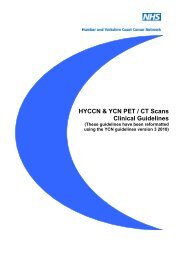Network Supportive Care Pathway - North East Yorkshire and ...
Network Supportive Care Pathway - North East Yorkshire and ...
Network Supportive Care Pathway - North East Yorkshire and ...
You also want an ePaper? Increase the reach of your titles
YUMPU automatically turns print PDFs into web optimized ePapers that Google loves.
HYCCN HIGH LEVEL SUPPORTIVE CARE PATHWAY<br />
The pathway has four key components identified that would significantly mprove the patients’ experience<br />
a = Holistic Assessment<br />
© = Key Discussion Point<br />
♦ = Single Contact with the<br />
assigned Key Worker<br />
i = Patient/carer information<br />
Identified Key Components Stage on <strong>Pathway</strong> Dependant On<br />
Information available <strong>and</strong> offered<br />
i Pre- referral <strong>and</strong> Screening Programmes<br />
Accessible Health Promotion Information .<br />
Support <strong>and</strong> Advice from the Practice Nurse, (<strong>and</strong><br />
Triage if required). GP following NICE<br />
guidelines for timely referral<br />
Key discussion point<br />
Fast Track system or what happens next<br />
Information offered<br />
i © GP / Symptoms<br />
Will include all access routes (A & E, Emergency<br />
Admission, GP Direct Access to tests etc)<br />
GPs having the agreed timed site<br />
specific pathways using a symptom based approach<br />
to select the appropriate test / referral<br />
Information offered<br />
Key contact identified to navigate investigations<br />
Patient support may not be Specialist CNS<br />
Key worker(kw) identified - this may be the CNS<br />
Meet kw contact details given<br />
Holistic Assessment/Information offered<br />
Key discussion point - diagnosis given next<br />
steps explained<br />
i ♦ Diagnostic tests<br />
(MDT may occur after 1st test or later in the<br />
pathway)<br />
a © i ♦ Diagnosis <strong>and</strong> staging<br />
Patient will be presented at MDT<br />
Direct Access resources so tests can be carried<br />
out before referral (not 2ww) Requesting the<br />
appropriate test to inform diagnosis <strong>and</strong> practice<br />
staff having<br />
ability to offer support<br />
Co-ordination of tests to reduce visits <strong>and</strong>adhere to<br />
agreed time scales<br />
Core member attendance at MDT to facilitate next<br />
steps – referral to<br />
oncology etc to happen at MDT.<br />
Development of the patient management plan<br />
Key worker same – contact / meet patient after<br />
MDT Re-visit Holistic Assessment<br />
Information offered<br />
Key discussion point - treatment options<br />
discussed<br />
Consider change in Key- worker depending on<br />
treatment modality – meet kw & contact numbers<br />
given<br />
Re-visit Holistic Assessment<br />
beginning <strong>and</strong> end of each treatment Information<br />
offered<br />
Key discussion point - What happens next<br />
Consider Key-worker change - may be to primary<br />
care meet kw & contact numbers given<br />
Discharge Holistic Assessment<br />
Information offered<br />
Key discussion point what happens next<br />
a © i ♦ Treatment planning options<br />
Decision to Treat – patient may need ‘thinking<br />
time’<br />
a © i ♦ Treatment<br />
Surgery, Chemotherapy, Radiotherapy,<br />
Watchful Wait<br />
a © i ♦ Living with Cancer<br />
Survivorship<br />
Recurrence/ relapse suspected<br />
Timely patient ‘h<strong>and</strong>-over’ of care with all relevant<br />
information. Communication with GP / Community<br />
Staff to enable timely & effective primary <strong>Care</strong><br />
support<br />
Timely patient ‘h<strong>and</strong>-over’ of care with<br />
all relevant information.<br />
Communication with treatment Team &<br />
GP / Community Staff to enable<br />
primary <strong>Care</strong> support<br />
Rapid access into secondary care for<br />
investigation of possible recurrence/<br />
further symptom management .Primary<br />
care to be aware when to re-refer<br />
At any stage of the pathway the patient referral for specialist palliative care input should be<br />
considered based on assessed need. If <strong>and</strong> when patients are assessed to have 6 – 12months to live<br />
they will move onto End of Life pathway<br />
adapted from YCN supportive care pathway
HUMBER AND YORKSHIRE COAST CANCER NETWORK<br />
High Level <strong>Supportive</strong> care pathway appendix<br />
Introduction<br />
Providing good supportive care is a vital element of the patients care pathway, highlighted in the<br />
NICE Improving supportive <strong>and</strong> palliative care for adults with cancer guidance (2004) <strong>and</strong> the<br />
Cancer reform strategy (2007).<br />
<strong>Supportive</strong> care pathway<br />
The aim of the supportive pathway is to support <strong>Network</strong> site specific groups to incorporate the<br />
supportive care aspects into their individual cancer pathways.<br />
The Cancer Clinical Nurse Specialist role is recognised to include a large element of supportive<br />
care <strong>and</strong> will be vitally important to the implementation <strong>and</strong> delivery of the key elements in the<br />
supportive pathway.<br />
The supportive care pathway starts from pre referral through active treatment, living with cancer <strong>and</strong><br />
survivorship, recurrence <strong>and</strong> subsequent treatment. The pathway would end if a patient has been<br />
assessed as having 6 – 12 months to live <strong>and</strong> they will be moved onto the Palliative/end of Life<br />
<strong>Pathway</strong>. It is recognised that there is a potential overlap <strong>and</strong> dove-tailing required for patients as<br />
they moved from the supportive pathway into the end of life pathway.<br />
The supportive care pathway has been developed based on the four elements that were identified<br />
to make the most difference to patient experience. These are as follows: -<br />
Holistic Assessment (a)<br />
The Holistic assessment also includes <strong>Supportive</strong> <strong>Care</strong> Planning & Appropriate <strong>Care</strong> Delivery The<br />
following domains are covered in the national Holistic Needs assessment Guide, which has been<br />
agreed to be adopted for use by the HYCCN:<br />
1. Background information <strong>and</strong> assessment information/preferences<br />
2. Physical well-being<br />
3. Social <strong>and</strong> occupational well-being: including managing at home <strong>and</strong> in the community,<br />
Work <strong>and</strong> finance, family <strong>and</strong> close relationships, social <strong>and</strong> recreational.<br />
4. Psychological well-being<br />
5. Spiritual well-being<br />
Also included in the holistic assessment is: -<br />
• the development of a care plan to meet the needs identified in the assessment<br />
• the delivery of care required as part of the care plan<br />
• appropriate referral to other services to enable the delivery of the care required as part of the<br />
care plan<br />
1
Single Contact with the assigned Key Worker ()<br />
The initial Single point of contact for patients will be identified for patients at the diagnosis of their<br />
cancer, for some patients who have been fast tracked for investigations this may be sooner if<br />
appropriate to coordinate care. It is expected that the Key worker will change along the pathway as<br />
patient needs, treatments <strong>and</strong> care settings dictate<br />
Key Discussion Point (©)<br />
These are the points in the pathway where significant information/discussions take place e.g.<br />
diagnosis <strong>and</strong> treatment discussions. It is expected that key discussions will occur <strong>and</strong> future<br />
planning will take place at the beginning <strong>and</strong> end of each treatment episode e.g Surgery,<br />
chemotherapy, radiotherapy <strong>and</strong> when the patient is discharged from active treatment into followup/living<br />
with <strong>and</strong> beyond cancer or onto palliative/end of life pathway.<br />
Patients will be supported during the key discussions to be as involved in the decision making<br />
process as they want to be<br />
Patient Information (i )<br />
Patients <strong>and</strong> carers will be offered the minimum information identified on the site information<br />
pathway, (which incorporates generic information). They will be assessed for any additional<br />
information needs <strong>and</strong> offered additional information to meet that need. The will be provided with<br />
support to underst<strong>and</strong> <strong>and</strong> cope with the information provided. The information will be sufficient to<br />
enable the patient to play as active a role in their own care <strong>and</strong> decision making processes as they<br />
have decided is appropriate for them.<br />
2

















